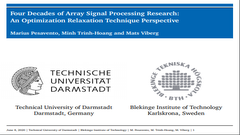报告详情
Four Decades of Array Signal Processing Research: An Optimization Relaxation Technique Perspective
摘要
关键词
报告人
Pesavento Marius
Communication Systems Group;Technische Universitat DarmstadtMarius Pesavento received the Dipl.-Ing. degree in 1999 and the Dr.-Ing. degree in electrical engineering in 2005, both from Ruhr-University Bochum, Bochum, Germany, and the M.Eng. degree from McMaster University, Hamilton, ON, Canada, in 2000. Between 2005 and 2009, he held research positions in two start-up companies. In 2010, he became an Assistant Professor for robust signal processing and a Full Professor for communication systems in 2013 with the Department of Electrical Engineering and Information Technology, Technical University Darmstadt, Darmstadt, Germany.
His research interests include robust signal processing and adaptive beamforming, high-resolution sensor array processing, multiantenna and multiuser communication systems, distributed, sparse, and mixed-integer optimization techniques for signal processing and communications, statistical signal processing, spectral analysis, and parameter estimation. He served as an Associate Editor for the IEEE Transactions on Signal Processing during 2012–2016 and is currently a member of the Editorial Board of the EURASIP Signal Processing Journal. He is a member of the Sensor Array and Multichannel Technical Committee of the IEEE Signal Processing Society and the Special Area Teams Signal Processing for Communications and Networking and Signal Processing for Multisensor Systems of the EURASIP. He is the recipient of the 2003 ITG/VDE Best Paper Award, the 2005 Young Author Best Paper Award of the IEEE Transactions On Signal Processing, and the 2010 Best Paper Award of the CrownCOM Conference.
Trinh Hoang Minh
Communication Systems Group;Technische Universitat DarmstadtMinh Trinh-Hoang received the M.Sc. degree in electrical engineering in 2017 from Technical University Darmstadt, Darmstadt, Germany, where he is currently working toward the Ph.D degree. His research interests include statistical signal processing, array processing, and numerical computation.
Mats Viberg
Blekinge Institute of TechnologyMats Viberg received the M.Sc. degree in applied mathematics in 1985 and the Ph.D. degree in automatic control from Linköping University, Linköping, Sweden, in 1989.
Dr. Viberg has served in various capacities in the IEEE Signal Processing Society, including the Chair with the Technical Committees on Signal Processing Theory and Methods and Sensor Array and Multichannel Signal Processing as well as member at large with the Board of Governors. He has also served in various capacities with the Swedish Research Council (VR). He was the recipient of the two paper awards from the IEEE Signal Processing Society, the Excellent Research Award from the VR, and the EURASIP European Group Technical Achievement Award. He is a member of the Royal Swedish Academy of Sciences and the Royal Society of Arts and Sciences in Gothenburg, Sweden.
全部评论
重要日期
-
会议日期
06月08日
2020
至06月11日
2020
-
01月12日 2020
初稿截稿日期
-
04月15日 2020
提前注册日期
-
12月31日 2020
注册截止日期
主办单位
承办单位
联系方式
- Prof. Zhiguo Shi
- zj******@gmail.com
历届会议
-
2024年07月08日 美国 Corvallis
2024 IEEE 13th Sensor Array and Multichannel Signal Processing Workshop (SAM) -
2018年07月08日 英国
2018 IEEE 10th Sensor Array and Multichannel Signal Processing Workshop (SAM) -
2016年07月10日 巴西 Rio de Janeiro,Brazil
2016年IEEE传感器阵列和多通道信号处理研讨会 -
2014年06月22日 西班牙
2014 IEEE第8届传感器阵列和多通道信号处理研讨会



发表评论